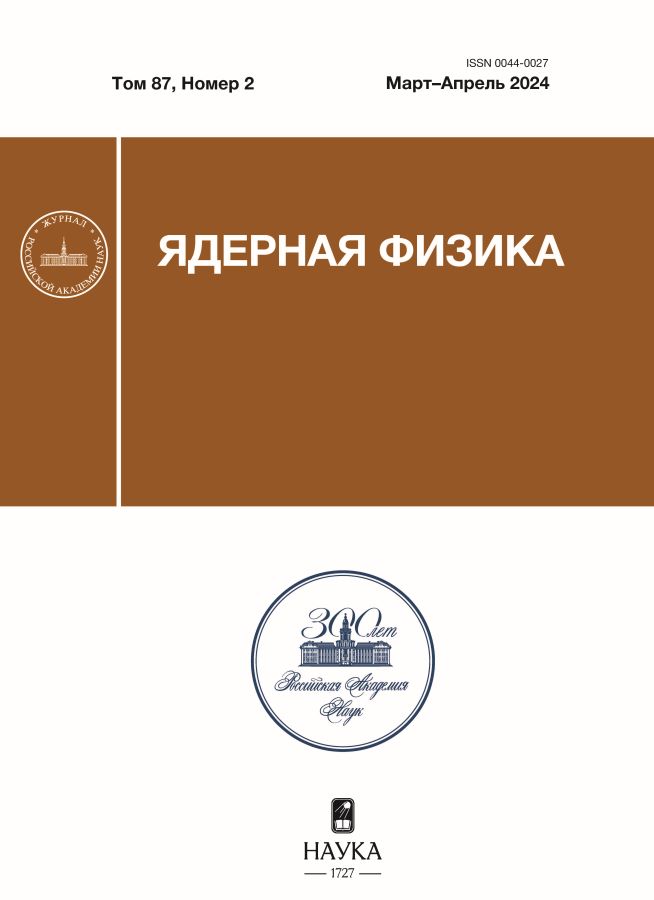On the classical approach to describing the diffusion of cosmic rays in a turbulent medium
- Авторлар: Uchaikin V.V.1, Kozhemyakin I.I.1, Litvinov V.A.2
-
Мекемелер:
- Ulyanovsk State University
- Barnaul Law Institute of the Ministry of Internal Affairs of Russia
- Шығарылым: Том 87, № 2 (2024)
- Беттер: 96-101
- Бөлім: ЭЛЕМЕНТАРНЫЕ ЧАСТИЦЫ И ПОЛЯ. Теория
- ##submission.datePublished##: 07.10.2024
- URL: https://cardiosomatics.ru/0044-0027/article/view/674662
- DOI: https://doi.org/10.31857/S0044002724020053
- EDN: https://elibrary.ru/KRFFUS
- ID: 674662
Дәйексөз келтіру
Аннотация
The inhomogeneous structure of the interstellar medium (ISM) is characterized by largescale fluctuations that significantly affect the cosmic ray propagation process. Accounting for this influence can not only lead to adjustments in the diffusion process parameters but even to pass from differential operators to integral ones. The most crucial characteristics of a turbulent medium is its power spectrum. Including appropriate approximations of this spectrum allows us to consider this problem in the framework of the traditional diffusion approach [1, 2]. This article explores the analytical representations of this spectrum applied in the cosmic ray transfer theory, including the four-parameter Uchaikin—Zolotarev approximation, derived from the generalized Ornstein—Zernike equation. Testing of the latter revealed that, with carefully chosen parameters, it accurately replicates numerical modeling results both in the inertial interval and beyond. Therefore, it can be effectively employed in addressing cosmic ray transfer issues within a turbulent interstellar medium.
Толық мәтін
Авторлар туралы
Vladimir Uchaikin
Ulyanovsk State University
Хат алмасуға жауапты Автор.
Email: vuchaikin@gmail.com
Department of Theoretical Physics
Ресей, UlyanovskIlya Kozhemyakin
Ulyanovsk State University
Email: kozhilya@gmail.com
Department of Theoretical Physics
Ресей, UlyanovskVladimir Litvinov
Barnaul Law Institute of the Ministry of Internal Affairs of Russia
Email: vuchaikin@gmail.com
Ресей, Barnaul
Әдебиет тізімі
- А. Быков, И. Топтыгин, ЖЭТФ 70, 194 (1990).
- V. S. Ptuskin, Sov. Astron. Lett. 14, 255 (1988); https://ui.adsabs.harvard. edu/abs/1988SvAL…14..255P
- P. Reichherzer, L. Merten, J. Dörner, J. Becker Tjus, M. J. Pueschel, and E. G. Zweibel, SN Appl. Sci. 4, 15 (2022); https://link.springer.com/10.1007/ s42452-021-04891-z
- В. Зацепин, А. Панов, Н. Сокольская, Дж. Адамс мл., Х. Ан, Г. Башинджагян, Дж. Ваттс, Дж. Вефель, Дж. Ву, Т. Гузик, И. Изберт, К. Ким, М. Кристл, Е. Кузнецов, М. Панасюк, Э. Сио, Дж. Чанг, А. Фазели, Письма в Астрон. журн. 35, 377 (2009).
- A. Erlykin and A. Wolfendale, Astropart. Phys. 25, 183 (2006); https:// linkinghub.elsevier.com/retrieve/pii/S0927650506000041
- E. S. Seo and V. S. Ptuskin, Astrophys. J. 431, 705 (1994); http://adsabs. harvard.edu/doi/10.1086/174520
- B. R. Ragot and J. G. Kirk, Astron. Astrophys. 327, 432 (1997); https://ui. adsabs.harvard.edu/abs/1997A&A…327..432R
- В. В. Учайкин, УФН 183, 1175 (2013); http://ufn.ru/ru/articles/2013/11/ b/
- В. В. Учайкин, А. Д. Ерлыкин, Р. Т. Сибатов, УФН 193, 233 (2023); https: //ufn.ru/ru/articles/2023/3/a/
- L. I. Dorman, Cosmic Rays in the Earth’s Atmosphere and Underground (Kluwer Academ. Publ., Dordrecht; Boston, 2004).
- R. C. Tautz and A. Dosch, Phys. Plasmas 20, 022302 (2013); https://doi.org/ 10.1063%2F1.4789861
- J. Giacalone and J. R. Jokipii, Astrophys. J. 520, 204 (1999); https:// iopscience.iop.org/article/10.1086/307452
- A. Shalchi and B. Weinhorst, Adv. Space Res. 43, 1429 (2009); https:// linkinghub.elsevier.com/retrieve/pii/S0273117709000052
- А. С. Монин, А. М. Яглом, Статистическая гидромеханика. Механика турбулентности (Наука, Москва, 1967).
- B. B. Mandelbrot, The Fractal Geometry of Nature (W. H. Freeman, San Francisco, 1982).
- V. V. Uchaikin and V. M. Zolotarev, Chance and Stability: Stable Distributions and their Applications (Walter de Gruyter, 1999).
- V. V. Uchaikin, Gen. Relativ. Grav. 36, 1689 (2004).
- В. В. Учайкин, Итоги науки и техн. Сер. Соврем. мат. и ее прил. Темат. обз. 220, 125 (2023); https://doi.org/10.36535/0233-6723-2023-220-125-144
- В. В. Учайкин, Итоги науки и техн. Сер. Соврем. мат. и ее прил. Темат. обз. 221, 128 (2023); https://doi.org/10.36535/0233-6723-2023-221-128-147
- В. В. Учайкин, Итоги науки и техн. Сер. Соврем. мат. и ее прил. Темат. обз. 222, 115 (2023); https://doi.org/10.36535/0233-6723-2023-222-115-133
- T. Nozakura, Mon. Not. Roy. Astron. Soc. 243, 543 (1990).
- S. Buonocore and M. Sen, AIP Advanc. 11, 055221 (2021); https://doi.org/ 10.1063/5.0049401
- P. Peebles, The Large-scale Structure of the Universe, Princeton Series in Physics (Princeton University Press, 1980); https://press.princeton.edu/books/ paperback/9780691209838/the-large-scale-structure-of-the-universe
- L. Brandt and F. Coletti, Ann. Rev. Fluid Mech. 54, 159 (2022).
- D. Falceta-Gongalves, G. Kowal, E. Falgarone, and A. C.-L. Chian, Nonlin. Proc. Geophys. 21, 587 (2014); https://npg.copernicus.org/articles/21/587/ 2014/
- T. Inoue, R. Yamazaki, and S.-I. Inutsuka, Astrophys. J. 695, 825 (2009); https: //iopscience.iop.org/article/10.1088/0004-637X/695/2/825
- J.-F. Robitaille, A. Abdeldayem, I. Joncour, E. Moraux, F. Motte, P. Lesaffre, and A. Khalil, Astron. Astrophys. 641, A138 (2020); https://www.aanda.org/10.1051/ 0004-6361/201937085
- J. Cho and A. Lazarian, Mon. Not. Roy. Astron. Soc. 345, 325 (2003); https: //academic.oup.com/mnras/article/345/1/325/984760
- B. Burkhart, A. Lazarian, V. Ossenkopf, and J. Stutzki, Astrophys. J. 771, 123 (2013); https://iopscience.iop.org/article/10.1088/0004-637X/771/2/123
Қосымша файлдар










